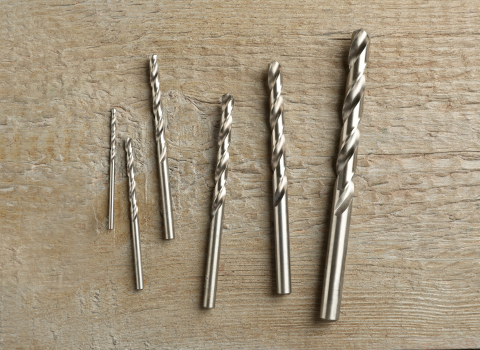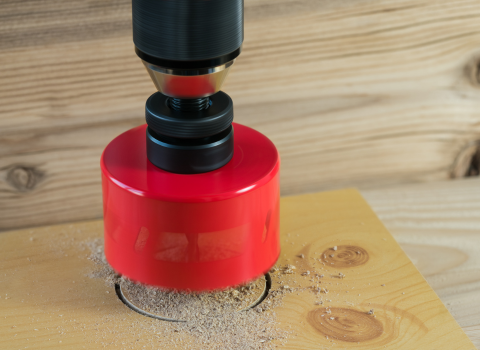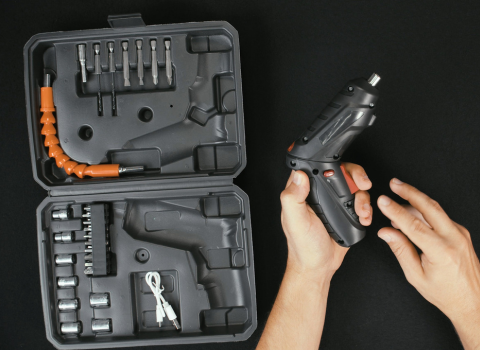
As DIY enthusiasts and professionals, we all know that having the right tools for the job is crucial. And when it comes to drilling using a driver kit or impact driver kit, choosing the right drill bit is just as important. Different materials, hole sizes, and applications require specific drill bits to ensure clean, accurate, and efficient drilling.
In this guide, we will explore the basics of drill bits, including the importance of selecting the right bit, an overview of different drill bit types, and their features, benefits, and common uses. We will also provide tips for effective drill bit usage, factors to consider when choosing a drill bit, and recommendations for power drill sets perfect for every job.
So, whether you're a woodworking hobbyist, a construction professional, or simply someone who enjoys tackling home improvement projects, join us as we dive into the world of specialized drill bits and learn how to choose the right bit for every job.
Understanding the Basics of Drill Bits
Before delving into the different types of drill bits, let's take a moment to understand the basics. Drill bits are cutting tools that attach to a drill, allowing you to create holes in various materials, such as wood, metal, plastic, and masonry. They typically consist of a shank, body, and tip, each designed to perform specific tasks.

The shank, which is the part of the bit that attaches to the drill, can vary in size and shape to fit different drill chucks. The body of the drill bit determines its overall strength, durability, and cutting ability. Lastly, the tip, also known as the drill point, is the part of the bit that makes initial contact with the material, allowing for precise drilling.
Now that we have covered the basics, let's move on to the importance of choosing the right drill bit for your projects.
The Importance of Choosing the Right Drill Bit
Choosing the right drill bit for your drilling tasks is of utmost importance. Using the wrong drill bit can result in damage to materials, ineffective drilling, and even accidents. On the other hand, selecting the correct drill bit ensures clean, accurate, and efficient drilling, improving overall work quality.
One of the key benefits of choosing the right drill bit is that it minimizes the risk of accidents. Using a drill bit that is too large or too small for the job can cause the bit to slip, resulting in injuries.

Additionally, using the wrong drill bit may exert excessive force on the drill, leading to motor strain, overheating, or even tool failure. By choosing the appropriate drill bit, you can prevent these issues and work safely.
Moreover, selecting the right drill bit extends the lifespan of both the bit and the drilling equipment. Using a drill bit in a brushless cordless drill that is designed for the specific material and task reduces wear and tear on the bit, preventing premature dulling or breakage. It also reduces strain on the drill, prolonging its lifespan and ensuring optimal performance.
Furthermore, understanding the importance of selecting the right drill bit enhances productivity. By using a drill bit that is tailored to the material, you can drill faster, more accurately, and with fewer complications. This saves you time and effort, allowing you to complete projects more efficiently.
Types of Drill Bits: A Brief Overview
When it comes to drill bits, there is a wide range of options available, each designed for specific materials and applications. Let's explore some of the common drill bit types and their features.
Twist Drill Bits
Twist bits are the most versatile and widely used. They feature spiral grooves that aid in removing debris during drilling, allowing for cleaner holes.

With a pointed tip, twist bits offer precise positioning and steady drilling. They are compatible with hand drills, electric drills, and drill presses, making them suitable for a variety of tasks.
Spade Bits
Spade bits, also known as paddle bits, are ideal for drilling large-diameter holes, typically in wood. They have a flat, wide design that allows for fast and efficient material removal.

Spade bits come in various sizes and often feature a threaded tip for improved accuracy. They are commonly used in rough carpentry, plumbing, and electrical work.
Hole Saw Bits
Hole saw bits are designed for cutting larger holes, usually in wood, plastic, or some metals. They consist of a cylindrical shape with serrated teeth that cut through the material.

Hole saw bits come in various sizes, allowing for versatility in creating different hole diameters. They are commonly used for installing doorknobs, pipes, and electrical wiring.
Auger Bits
Auger bits are specifically designed for drilling deep, clean holes in wood. They have a corkscrew-like thread that pulls the bit through the material, resulting in a more controlled drilling process.

Auger bits excel at removing debris, leaving behind smooth, clean holes. They are often used for drilling holes for large screws, bolts, and dowels.
These are just a few examples of drill bit types available. Each type offers unique characteristics, benefits, and suitable applications. In the upcoming sections, we will dive deeper into each type, discussing their features, common uses, and recommended scenarios.
Making the Right Choice: Factors to Consider
Considering the Material to be Drilled
When selecting drill bits for wood, spade bits, auger bits, and hole saw bits are commonly favored for their efficient wood-cutting capabilities. Metal drilling requires twist drill bits, step drill bits, or multi-material drill bits tailored for metal surfaces. Masonry drilling necessitates masonry drill bits, carbide-tipped drill bits, or hammer drill bits specially designed for concrete and brick. Moreover, different drill bit materials like high-speed steel, cobalt, and carbide are suitable for specific materials and applications, emphasizing the importance of understanding the properties of the material being drilled.
Analyzing the Size of the Hole Required
Understanding the required hole size is crucial for achieving precision and accuracy in drilling tasks. The desired hole diameter significantly influences the choice of drill bit, as various bit types are available for different hole sizes. For larger holes, commonly used bits include hole saw bits, auger bits, and Forstner bits due to their ability to drill wide diameters. Conversely, smaller holes are typically created using twist drill bits, brad point bits, or spade bits, depending on the material. Additionally, the depth of the hole required also plays a significant role in selecting the appropriate drill bit type for the job.
Understanding Your Drill’s Specifications
When choosing drill bits, it's essential to consider the drill’s specifications. The chuck size determines the maximum shank diameter of the bit it can accommodate. Corded and cordless drills have different power and voltage specifications, impacting bit choice. Impact drivers have specific bit requirements due to their high-torque capability. Understanding speed settings, torque, and hammer function is crucial. Also, the compatibility with different bit shanks, such as round, hex, or SDS, is important. Dewalt, Ryobi, Milwaukee, Craftsman, and Lowe have a variety of drill bits that customers can purchase online via Amazon or by visiting the nearest Home Depot.
Tips for Using Drill Bits Effectively
Ensuring Proper Installation of the Bit
To achieve precise and accurate drilling, it's crucial to ensure the proper installation of drill bits. Securely fastening the bit not only prevents accidents but also improves drilling efficiency. Following the manufacturer's instructions for installation is key to ensuring safety and minimizing the risk of the bit coming loose during operation. Regularly inspecting the bit's installation can help prevent damage to the bit or the workpiece.
Regular Maintenance and Care for Longevity
Maintaining drill bits is essential for longevity and optimal performance. Storing them in a clean, dry area prevents corrosion and damage, while regular cleaning removes debris buildup. Sharpening dulled bits preserves their cutting effectiveness, and applying lubrication reduces friction and heat, extending their life. By following these maintenance practices, you can ensure that your drill bits and compact drill remain reliable and efficient for a longer duration.
Safety Measures When Using Drill Bits
When working with drill bits and cordless screwdriver, it's crucial to prioritize safety. Wearing personal protective equipment, like goggles, shields your eyes from flying debris while drilling. Adequate lighting in the work area is essential to minimize the risk of accidents. Properly securing the workpiece prevents unexpected movement during drilling, enhancing overall safety. Additionally, using the correct drill bit for the material being drilled not only improves efficiency but also ensures a safer working environment. Regular inspection of drill bits for any signs of damage or wear is imperative to reduce the risk of breakage during use.
Advanced Drill Bits for Specialized Tasks
Exploring specialized tasks demands advanced drill bits capable of handling unique materials and surfaces. Masonry and tile bits cater to hard surfaces like concrete, while step and countersink bits accommodate woodworking needs. These advanced tools expand the versatility of a standard drill kit, providing precision and efficiency for specific applications. From crafting custom shelves to installing intricate fixtures, having the right tool combo for the job can make all the difference.
Exploring Masonry and Tile Bits
When working with hard materials like concrete, stone, or brick, masonry drill bits are essential. These bits are designed to handle tough surfaces, providing efficient debris removal during drilling with their high-speed spiral flutes. On the other hand, tile bits, with carbide tips, are engineered for ceramic and porcelain tiles, featuring reduced friction coatings to prevent chipping or cracking. Both masonry and tile drill bits are constructed to be impact-resistant. lightweight, durable for long-lasting use, making them indispensable additions to any tool set.
Discovering Step and Countersink Bits
Step and countersink bits are a versatile option for woodworking and metal fabrication. Step bits eliminate the need for multiple drill bits by allowing the drilling of multiple hole sizes. Countersink bits create conical holes, enabling screws to sit flush with the material's surface. Their combined version offers drilling and finishing versatility in one tool. These bits are commonly used in various applications and adjustable step bits provide flexibility to drill different hole sizes using a single tool.
Pros and Cons of Different Types of Bits
Evaluating the Benefits and Limitations of Twist Bits
When working with twist bits, it's essential to consider their versatility. These bits can drill through wood, metal, plastic, and other materials, making them a go-to choice for many DIY enthusiasts. Their simple and effective design also makes them widely available and affordable. However, it's crucial to maintain steady hand control to prevent wandering during drilling, as these bits can be prone to deviation. Additionally, they should not be used on extremely hard materials like masonry to avoid the risk of bit breakage. To ensure longevity and efficient drilling, opting for sharp, high-speed steel twist bits can significantly reduce the risk of heat buildup and premature dulling.
Weighing the Strengths and Weaknesses of Spade Bits
When using spade bits, it's important to consider their strengths and weaknesses. These bits are ideal for plumbing and electrical work, efficiently drilling large, rough holes. Their flat, broad design allows for quick, aggressive drilling, reducing overall drilling time. However, care must be taken when drilling softer materials, as spade bits can splinter them. It's crucial to avoid using spade bits at high speeds for extended periods to prevent overheating. Opting for spade bits with spur cutters and sharp edges greatly enhances drilling performance.
How do I properly use a power drill and its attachments?
To properly use a power drill and its attachments, start by selecting the appropriate drill bit for your specific task. Securely attach the bit to the drill, making sure it is tightened properly. Then, set the drill to the desired speed and apply steady pressure while drilling into your material.
Recommended Power Drill Set Perfect for Every Job
Were you looking for the perfect tool combo kit? Look no further than the SuperDrill from SuperBrand Tools.

The SuperDrill 3.6 max volt is a highly adaptable power tool suitable for any household hand tools, providing drilling, screwing, and unscrewing functions with a maximum of 250 rpm. It comes with a built-in LED light and lithium-ion battery for practicality and efficiency. Additionally, its compact size allows it to accommodate 42 different chuck sizes, reducing the requirement for additional tools.

The SuperDrill Full Package includes a wide range of drill bits and drivers, as well as a sturdy ABS plastic carry case with a quarter-inch thickness. The ABS plastic case of the SuperDrill provides secure storage for drill bits and screw heads, ensuring safety and organization. The cordless mini drill offers great value with its reasonable price and a warranty of up to 90 days and free shipping for orders over $75.
Conclusion
Choosing the right drill bit is crucial for achieving precise and efficient results in your projects. Each type of drill bit offers unique features and benefits that cater to specific applications. Whether you're using twist bits, spade bits, hole saw bits, or auger bits, understanding their characteristics and best uses will help you make an informed decision. Remember to consider factors such as the material to be drilled, the size of the hole required, and your drill's specifications when selecting a bit. Regular maintenance and proper installation are also essential for maximizing the longevity of your drill bits. When selecting a power drill set, take into account elements like the planned usage, type of power source (corded or cordless), battery lifespan, torque adjustments, and included accessories. Selecting a drill set that matches your requirements and preferences is crucial in obtaining the most suitable tool for the task.
















